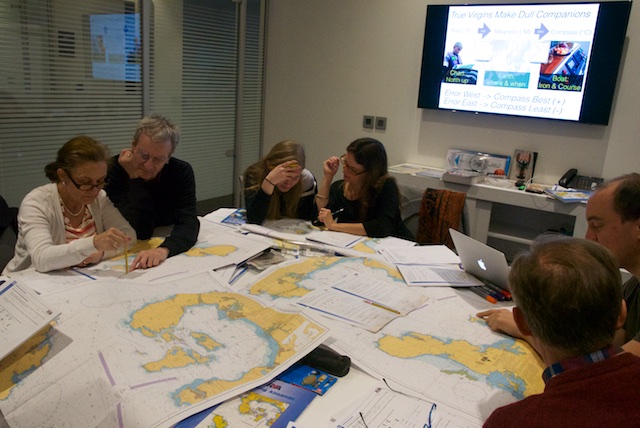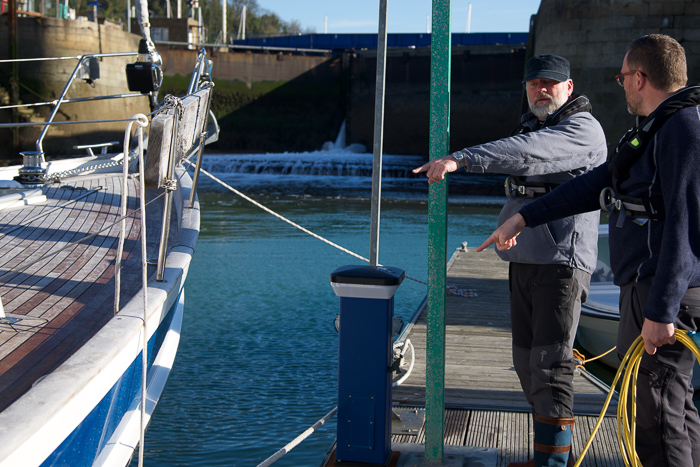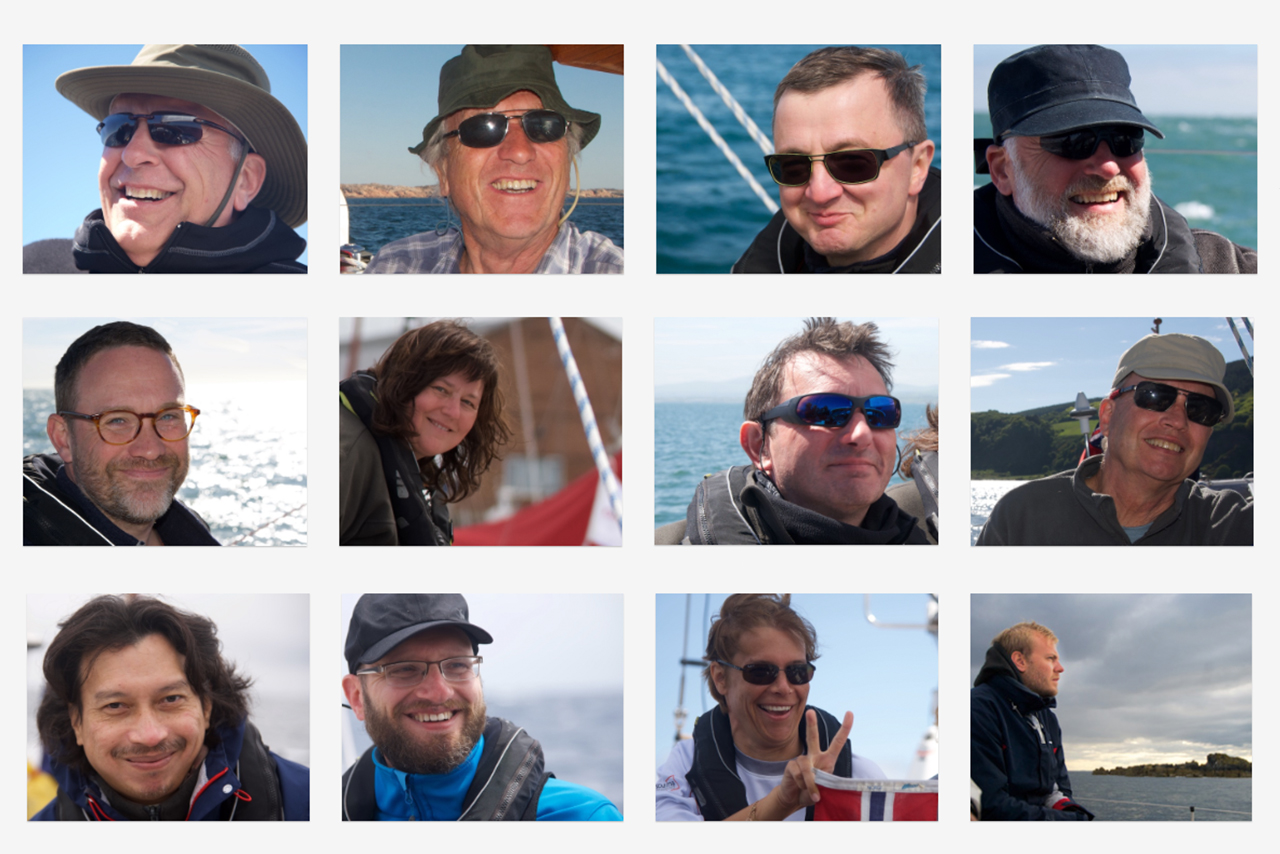Offshore Sail Training
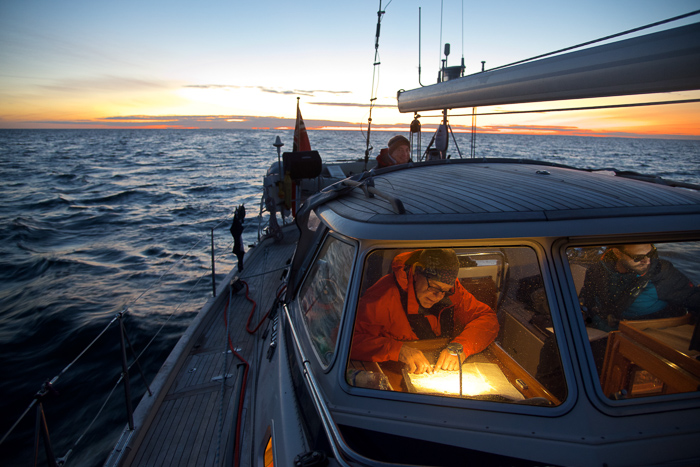
Navigating during an offshore passage crossing the North Sea.
Offshore Sailing in a Thrilling Surrounding
Includes both offshore and coastal sailing for the more experienced crew
Places, weather and conditions that possibly stretch your normal comfort zone, but never too much!
Yet: Fearless adventures with a maximum feeling of safety
Apply your theoretical knowledge:
– learn where you need to be exact and where approximations are accepted and still keep you safeOptimal learning conditions with just 4 participants and typically 7 days of cruising
Typically these legs are in tidal waters
Get prepared for your Yachtmaster Offshore Exam
Enjoy learning on a Hallberg-Rassy many sailors are dreaming of!
Feel the comradeship of the Reginasailing family – learning and sharing experiences together
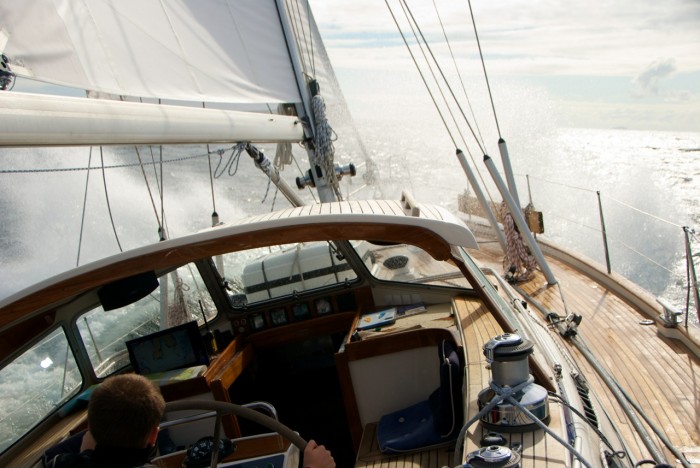
.
The syllabus
- Passage planning – Get prepared!
- Skippering – Take responsibility!
- Crew Communications – Instruct your crew clearly, politely and respectfully!
- Tidal Calculation – Play the tides!
- Watch schemes – For the longer passages!
- Offshore Meteorology and weather sources – know your limits!
- Classic Navigation – Get prepared for your Yachtmaster Exam!
- Radar Navigation – Your third eye!
- Sail and Storm tactics with heaving-to (weather permitting)
- Seasickness, security, risks of accidents and other medical issues
- Customs and other issues when entering a foreign country
- Safety Systems – avoiding the emergency!
- Emergency Situations – What if… despite a comprehensive safety system!
Man Over Board, Sinking, Fire, Gas, Storms, Anxiety, Seasickness etc - Anchoring – Feel the freedom!
- Your Questions – Get the answers!
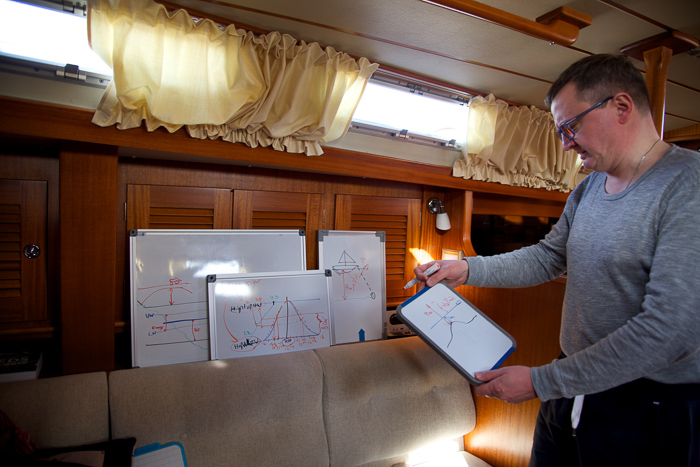
Comparing tidal calculations for anchoring
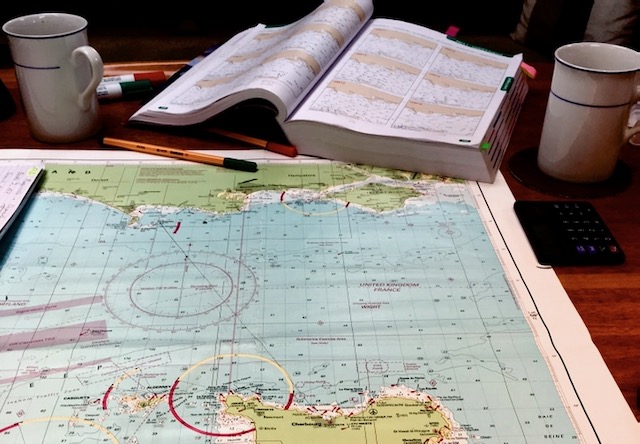
Crossing the English Channel is a typical Offshore Sail Training leg.
Examples of topics that can form part on an offshore sail training leg:
| 1. Seamanship – Crew briefing – Use of checklists – Organising navigation, deck-work and domestic duties – Crew welfare and seasickness – Awareness of meteorological trends – Discussing watch keeping – Delegating responsibilities – Planning for emergencies, such as abandon ship – How to give firm, clear and sovereign, yet friendly and calm, directions 2. Handling under Power 3. Handling under Sail 4. Man-overboard
| 5. Mooring and Anchoring – Picking up a buoy under motor and under sail only – Leaving a buoy under motor and under sail only – Choosing and judging an anchorage – Discussing various types of anchors – Decision on length of scope – Anchoring with more than one anchor – Setting an anchor properly – Taking bearings and leading lines – Setting electronic anchor watch (GPS, iPhone, Echosounder, Radar) – Raising anchor and discussing a foul anchor – Use of anchor sail 6. Navigation 7. Pilotage 8. Adverse weather tactics (weather permitting) 9. Technical | |||||
A great book covering the subjects is “The Complete Yachtmaster” by Tom Cunliffe. Buy it here.
More books can be found here.
Please don’t forget to use your discount code rs-BHAPGG10 when ordering from bookharbour.com.
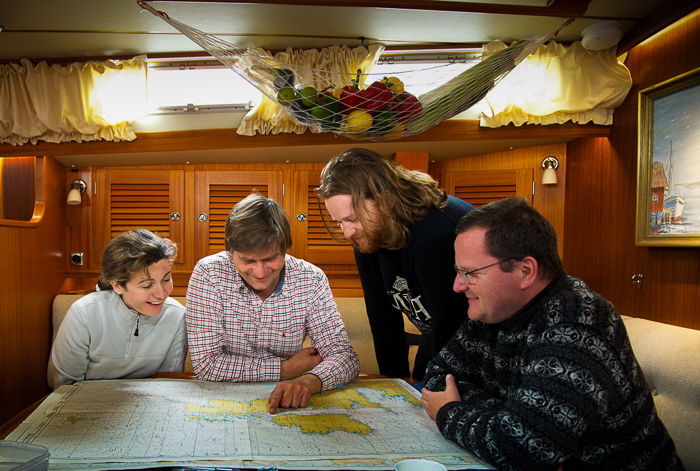
Passage planning sailing from Ireland to Scotland.
Regina Laska and your RYA Yachtmaster Instructor
The facts about the boat can be find here. She is a commercially coded vessel for Area-1 offshore sailing and I personally cater for the guests.
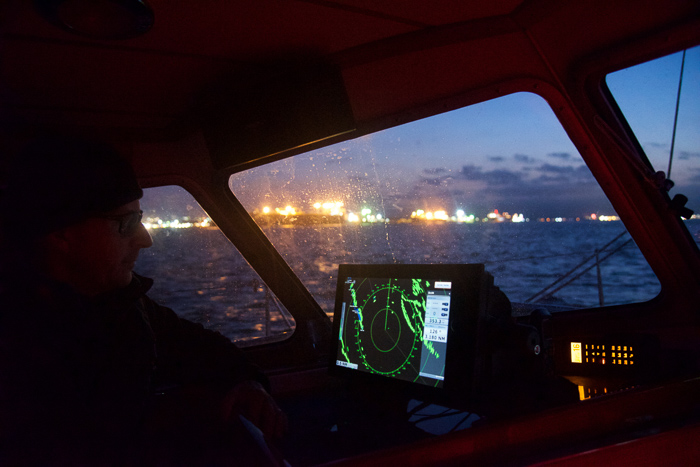
The Radar becomes your third eye. With a modern state-of-the-art Solid-State radar with Satellite Compass for a stable picture gives you the ultimate look-out. It’s fun to learn to interpret the different echoes!
Next available Offshore Sail Training Legs
Leg 2-2023: Lymington/UK – Lorient/France (29 Apr – 10 May 2023).
Leg 3-2023: Lorient/France – La Coruna/Spain (20 – 31 May 2023)

To quickly determine a COG by means of a current triangle during a stressful situation is part of an exercise.
Price
Click on the links above for the corresponding legs to see what they cost. Their price differ depending on the total length of the leg.
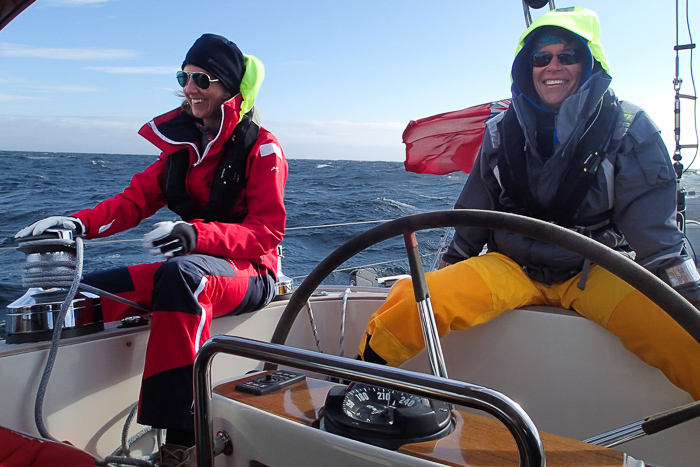
Having fun sailing in a gale.
What do others say?
Read the many testimonials and crew’s blogs and get a picture of the atmosphere and learning experience onboard!
Ho to become an RYA Yachtmaster Offshore
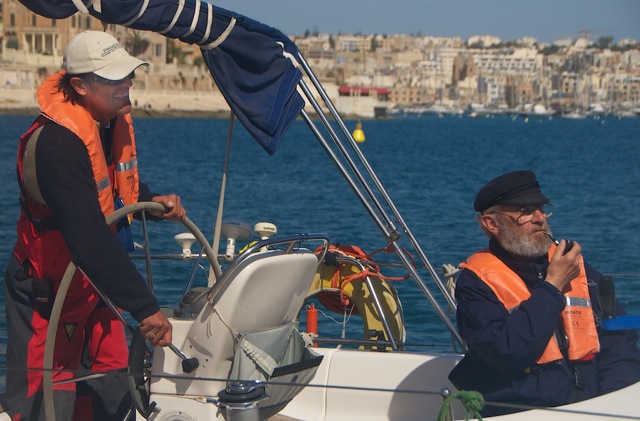
A yachtmaster student from Italy being assessed in Malta by the RYA Yachtmaster Examiner Allan Hogton who flew in from the UK in order to do the examination.
The RYA Yachtmaster Exam is the pinnacle of sailing qualifications and is the highest achievement within the RYA system. It is very well respected anywhere in the world. With a Commercial Endorsement you can work professionally on boats.
A Yachtmaster Exam is the pinnacle of sailing qualifications and is the highest achievement within the RYA system. It is very well respected anywhere in the world. With a Commercial Endorsement you can work professionally on boats.
While the Competent Crew, the Day Skipper and the Coastal Skipper are 5-days courses, the Yachtmaster is not. The Yachtmaster is a “Certificate of Competence” and is, in other words, purely an exam. As a Yachtmaster Instructor, I can teach you the necessary knowledge and skills, but it is a Yachmaster Examiner who will assess you and do the actual exam.
What you need in order to apply for a Yachtmaster exam is the following:
– Theory knowledge equivalent to the RYA Coastal Skipper & Yachtmaster theory
– 50 days sea-time
– 5 days as skipper
– 2,500 miles of experience (of which half in tidal waters)
– 5 passages over 60 miles, including 2 overnight and 2 as skipper
The exam itself, which is a purely practical and oral test, takes some 8-12 hours for one candidate and 10-18 hours for two candidates. You need to know all the necessary theory, starting from the rules of the road to weather, safety, rescue and tidal calculations. You are assessed as a skipper (practical), how you handle your crew, the boat and your navigation and you need to know a fair amount of how to handle and maintain a boat, starting from sail trim to diesel engines. You will also have to prepare a passage plan including a tidal gate to your examiner.
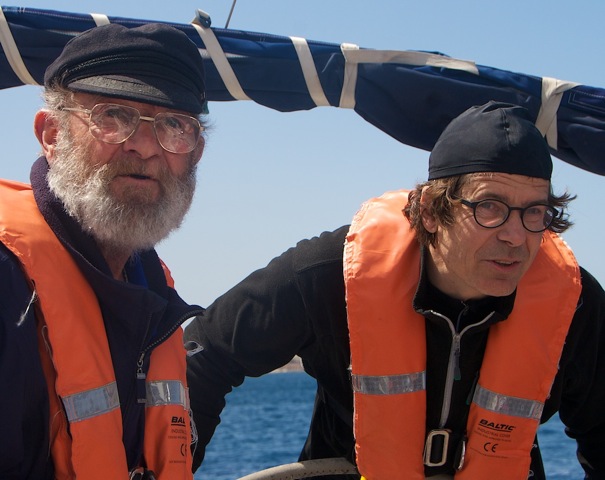
Suddenly the examiner shouts: “Danger ahead! Engine not working! What do you do?” The Swedish student (right) taking his Yachtmaster Exam needs to take quick decisions giving firm orders to his crew in this simulated critical situation
Since it is not easy to know exactly what you need to know for your Yachtmaster exam and in order to help students to brush up their knowledge, especially within tidal calculations, there are “Yachtmaster Prep Courses” which als go under the name “Refresher Course” or “Prep Week”.
The Yachtmaster Prep course is all about preparing you for the examination. There is no way that someone could be taught everything needed to pass a Yachtmaster exam in one course. In reality, the course is a mix of vessel familiarisation, an opportunity for the student to explore the exam area and brush up the candidate’s skills and knowledge. The Yachtmaster exam has a syllabus, both concerning theory and practical. We will together identify any areas of weakness which require attention and deal with them in order to coach you through the syllabus with the goal that you will pass the exam. Taking this examination can appear to be a daunting experience, so we need to avoid any nasty surprises and give you the confidence to pass. Having previously worked as the chief instructor of Malta Sailing Academy, and now running my own RYA Training Centre Regina-Sailing, I have the experience to guide you through the process, with a long list of successful candidates. Having said that, you do need to come well prepared in order to apply for the exam.
The Yachtmaster Prep course is a “brush-up”, showing you the small tricks and practicing the skills that an examiner would be looking at specifically.
Please see here for a typical Yachtmaster Prep Course onboard Regina Laska.

